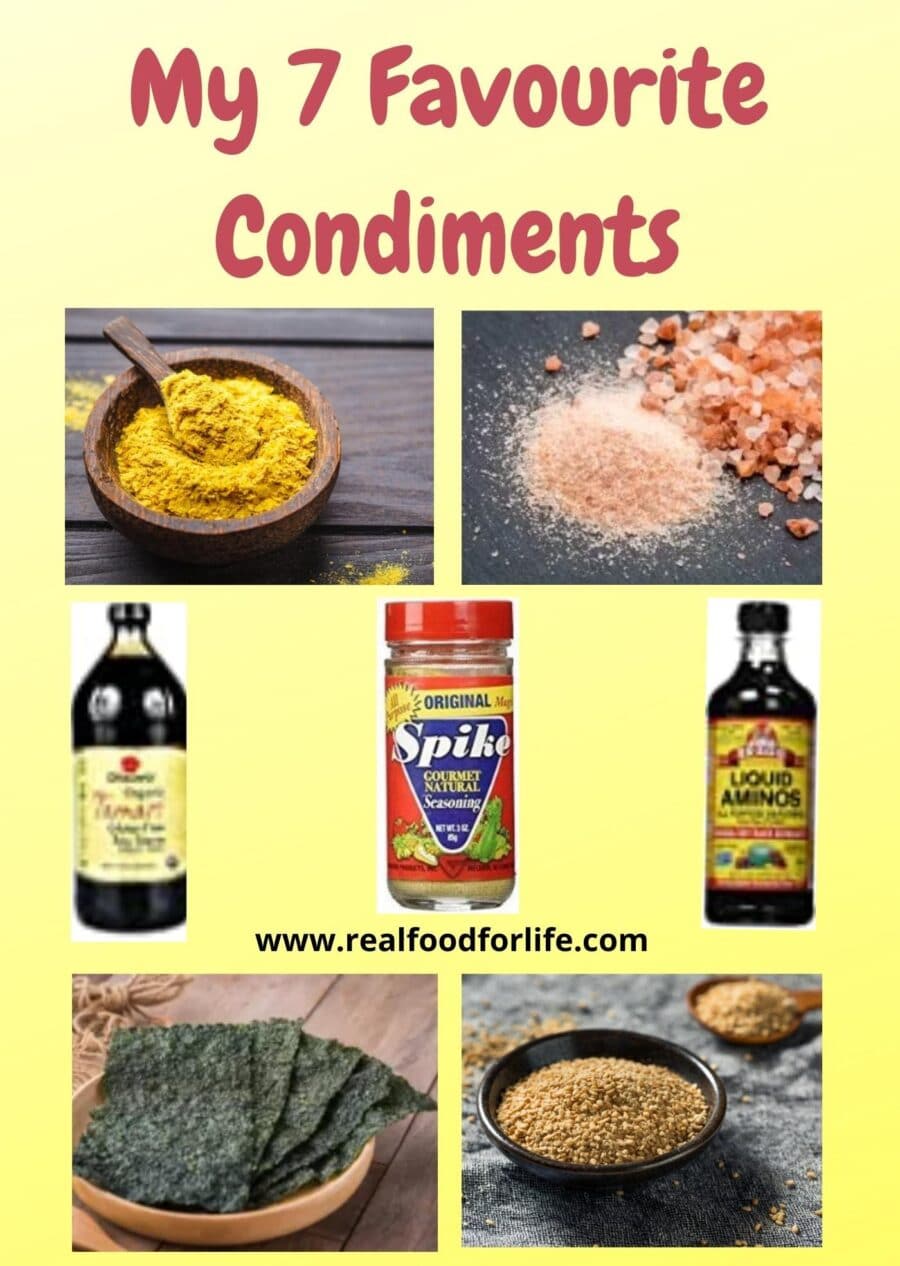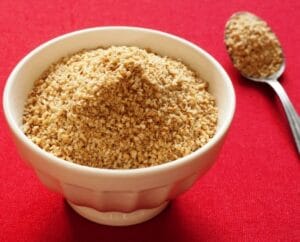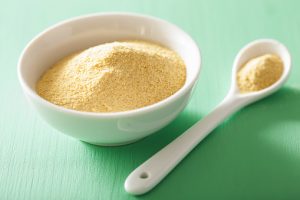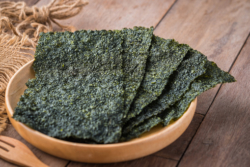Here are some of my favourite condiments that I use in my healthy delicious meals with some explanation. They are all superfoods so they are a great addition to your recipes. There are many new ones that you may not have heard of yet. If you have some information on one that you would like to share, here is the place to do it. I continually update this list until I have them all in here. Please feel free to tell us which ones you love to use.

My Favourite Healthy Condiments
Spike Seasoning

Ingredients: salt and sea salt crystals, hydrolyzed vegetable protein, yeast, toasted onion, onion powder, soy flour, orange powder, celery root powder, celery leaf powder, garlic powder, kelp, dill, Indian curry, white pepper, horseradish, lemon and orange peel, savory, mustard flour, red and green bell peppers, parsley, tarragon, safflower, rose hips, mushroom powder, spinach powder, paprika, tomato powder, sweet cayenne pepper, oregano, marjoram, sweet basil, rosemary, and thyme.
Braggs All Purpose Seasoning 

It is properly known as Bragg Liquid Aminos which is a Certified NON-GMO liquid protein concentrate, derived from healthy soybeans.
Ingredients: Bragg Liquid Aminos are made from health-giving, NON-GMO soybeans and purified water. They are an excellent, healthy, gourmet replacement for Tamari and Soy Sauce. Not fermented or heated and Gluten-Free. Bragg’s has a small amount of naturally occurring sodium. No table salt is added. If less sodium is desired, use a 6 oz. Bragg’s spray bottle and dilute with 1/3 distilled water or to taste and then either add in or spray on food.
Silverware Set, APEO 20 Piece Flatware Set, Stainless Steel Cutlery Set, Service for 4, Square Handle, Tableware Set include Knife Fork Spoon, Mirror Finish, Dishwasher Safe
Save 50% on select product(s) with promo code 50KTEMGC on Amazon.com
Soya Sauce or Tamari?
I choose tamari which literally means liquid pressed from soybeans, originally it was the thick brown liquid that pooled in casks of fermenting soybean miso. For centuries this tamari was a rare delicacy 
This tamari is organic and brewed from whole soybeans, sea salt, water, and koji (Aspergillus hacho). It is gluten-free and popular with those who have wheat allergies.
By contrast, commercial soy sauces (even some labeled as shoyu or tamari) are usually made from soybeans that have been defatted with hexane, a petroleum derivative. Common shortcuts are artificial fermentation methods including genetically engineered enzymes. In fact, most soy sauce is actually caramel-colored water with lots of salt, hydrochloric acid-treated soy isolate, and sugar added.
Carefully choose your soy sauce as you would an olive oil or a fine wine. Look for the words traditionally brewed and natural or organic, and make sure the manufacturer backs this up.
The next 2 are My Favourite Condiments to sprinkle on my food.
Gomashio Seasoning
 This is an old favourite condiment in my kitchen. Here is an easy to make recipe: Gomashio Seasoning or you can buy it Gomashio Japanese Sesame Salt Seasoning Fresh Ground Spice Mix.
This is an old favourite condiment in my kitchen. Here is an easy to make recipe: Gomashio Seasoning or you can buy it Gomashio Japanese Sesame Salt Seasoning Fresh Ground Spice Mix.
I like to use Raw Organic Sesame Seeds and buy lots at the same time at a good price. Also, so I can make double the recipe above and have lots for other meals.
Nutritional Yeast Flakes
 These flakes add a tangy, cheesy taste to my food which is good since I don’t eat cheese. I add this to sauces and pesto as a replacement for Parmesan cheese. Nutritional yeast flakes are an inactive form of yeast and are a good source of protein (contain 18 amino acids and nine are essential ones that your body cannot produce). Nutritional yeast flakes are a great source of B vitamins and the minerals iron, selenium, and zinc. It is a very yummy favourite condiments for sure.
These flakes add a tangy, cheesy taste to my food which is good since I don’t eat cheese. I add this to sauces and pesto as a replacement for Parmesan cheese. Nutritional yeast flakes are an inactive form of yeast and are a good source of protein (contain 18 amino acids and nine are essential ones that your body cannot produce). Nutritional yeast flakes are a great source of B vitamins and the minerals iron, selenium, and zinc. It is a very yummy favourite condiments for sure.
Not to be confused with baker’s yeast, which is still active and can grow inside your stomach, depriving you of nutrients, or with brewer’s yeast, which is inactive but bitter.
Organic nutritional yeast is not fortified, so it does not have the same B vitamins and bright yellow color as conventional yeast flakes. Any fortified yeast cannot be organic certified. Try this very good variety of nutritional yeast: Druids Grove Organic Nutritional Yeast Flakes Kosher Certified
Himalayan Salt Is for Sure One of Favourite Condiments
 This is a rock salt that helps to re-mineralize your body with minerals and trace elements (Calcium, Magnesium, Potassium, Copper and Iron) which are essential to our health.
This is a rock salt that helps to re-mineralize your body with minerals and trace elements (Calcium, Magnesium, Potassium, Copper and Iron) which are essential to our health.
This salt is harvested in the Himalayan Mountains; it was formed in the last 250 million years. It is the very purest salt and is free of pollutants and toxins.
Salt is a necessary part of cooking as long as we do not use too much and use the right kind. I use Himalayan salt as it is rich in nutrients and minerals. Also, it is the kindest salt for the body.
One of my favourite condiments is seaweed flakes which I use instead of salt.
Dulse is red in colour and has a delicious fresh crisp flavor. Get the dried granules to sprinkle on food either during cooking or at the table.
 Nori is thin and its oily iridescence reflects the colors of the rainbow. Get it as dried granules that can be sprinkled on food either during cooking or at the table.
Nori is thin and its oily iridescence reflects the colors of the rainbow. Get it as dried granules that can be sprinkled on food either during cooking or at the table.
Bull Kelp is one of the tastiest seaweeds; it is not like any other kelp I have had. It is fine and tender. Great sprinkled on foods.
 This is a favourite tool for me in my kitchen to help make some of my favourite condiments. Magic Bullet Blender, Small, Silver, 11 Piece Set
This is a favourite tool for me in my kitchen to help make some of my favourite condiments. Magic Bullet Blender, Small, Silver, 11 Piece SetYou can learn how to plan and prepare super healthy meals with my 2-5-30 Healthy Diet Online Courses.



I also recently bought Liquid Aminos made from Coconut Sap at a Health Food store. It says Organic, Gluten Free, Dairy free and non- GMO. I presume this would also be a good alternative to commercial soy sauce and does not have soy in it either. It tastes pretty good, like soy sauce, but less salty.
That sounds good. It says Coconut Aminos, made from this natural sap and blended with sun dried, mineral-rich sea salt.
Have to say I have not seen it or tried it yet. I will now be looking into getting some. Thank you.